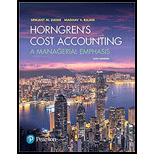
Concept explainers
Material-cost variances, use of variances for performance evaluation. Katharine Johnson is the owner of Best Bikes, a company that produces high-quality cross-country bicycles. Best Bikes participates in a supply chain that consists of suppliers, manufacturers, distributors, and elite bicycle shops. For several years Best Bikes has purchased titanium from suppliers in the supply chain. Best Bikes uses titanium for the bicycle frames because it is stronger and lighter than other metals and therefore increases the quality of the bicycle. Earlier this year, Best Bikes hired Michael Bentfield, a recent graduate from State University, as purchasing manager. Michael believed that he could reduce costs if he purchased titanium from an online marketplace at a lower price.
Best Bikes established the following standards based upon the company’s experience with previous suppliers. The standards are as follows:
| Cost of titanium | $18 per pound |
| Titanium used per bicycle | 8 lbs. |
Actual results for the first month using the online supplier of titanium are as follows:
| Bicycles produced | 400 |
| Titanium purchased | 5,200 lb. for $88,400 |
| Titanium used in production | 4,700 lb. |
- 1. Compute the direct materials price and efficiency variances.
Required
- 2. What factors can explain the variances identified in requirement 1? Could any other variances be affected?
- 3. Was switching suppliers a good idea for Best Bikes? Explain why or why not.
- 4. Should Michael Bentfield’s performance evaluation be based solely on price variances? Should the production manager’s evaluation be based solely on efficiency variances? Why is it important for Katharine Johnson to understand the causes of a variance before she evaluates performance?
- 5. Other than performance evaluation what reasons are there for calculating variances?
- 6. What future problems could result from Best Bikes’ decision to buy a lower quality of titanium from the online marketplace?
Want to see the full answer?
Check out a sample textbook solution
Chapter 7 Solutions
EBK HORNGREN'S COST ACCOUNTING
- Information pertaining to Noskey Corporation’s sales revenue follows: November 20X1 (Actual) December 20X1 (Budgeted) January 20X2 (Budgeted)Cash sales $ 115,000 $ 121,000 $ 74,000Credit sales 282,000 409,000 208,000Total sales $ 397,000 $ 530,000 $ 282,000Management estimates 5% of credit sales to be uncollectible. Of collectible credit sales, 60% is collected in the month of sale and the remainder in the month following the month of sale. Purchases of inventory each month include 70% of the next month’s projected total sales (stated at cost) plus 30% of projected sales for the current month (stated at cost). All inventory purchases are on account; 25% is paid in the month of purchase, and the remainder is paid in…arrow_forwardMirror Image Distribution Company expects its September sales to be 20% higher than its August sales of $163,000. Purchases were $113,000 in August and are expected to be $133,000 in September. All sales are on credit and are expected to be collected as follows: 40% in the month of the sale and 60% in the following month. Purchases are paid 20% in the month of purchase and 80% in the following month. The cash balance on September 1 is $23,000. The ending cash balance on September 30 is estimated to be:arrow_forwardBalance sheet information is useful for all of the following except:a) evaluating a company's financial flexibilityb) evaluating a company's liquidityc) assesing a company's riskd) determining free cash flowsarrow_forward
- Principles of Accounting Volume 2AccountingISBN:9781947172609Author:OpenStaxPublisher:OpenStax College
